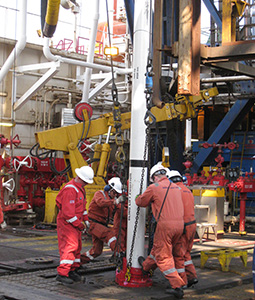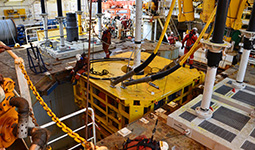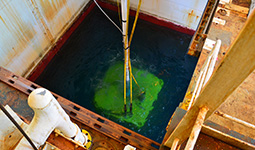Home > Highlighting JAPAN > Highlighting Japan April 2018 > The Maritime Nation of Japan
Highlighting JAPAN


Energy Resources from the Bottom of the Sea
Research is underway into the commercialization of natural methane hydrate believed to exist in the seabed layer in the waters surrounding the Japanese archipelago.
Methane hydrate, a substance resting in Japanese coastal waters also known as “burning ice,” has attracted attention in recent years. Methane hydrate is an offshore resource containing methane, the primary component of natural gas, and is believed to exist in the subsea strata 500 meters or deeper under the waters surrounding the Japanese archipelago. As methane characteristically releases roughly half the amount of carbon dioxide of coal when burned, it is expected to be used as a source of energy for city gas, power generation and fuel cells. The Japan Oil, Gas and Metals National Corporation (JOGMEC) is conducting research and development into methane hydrate’s potential to become a new energy resource as a member of MH21, Research Consortium for Methane Hydrate Resources in Japan.
“Methane hydrate is one of the clathrate hydrates, a type of solid where a guest molecule is trapped inside a cage of water molecules, and this forms a solid in an environment with low temperature and high pressure. Methane hydrate that has been artificially formed in something like ice, when it is brought close to a flame at ordinary temperatures, the emitted methane ignites and forms a flame, after which only water remains. That’s how it gets the name ‘burning ice,’” explains Yoshihiro Nakatsuka, Deputy Director of the Field Development team in the Methane Hydrate Research & Development Group at JOGMEC.
Full-scale research and development was started by MH21 in 2001 in response to “Japan’s Methane Hydrate R&D Program” published by the Ministry of Economy, Trade and Industry. The effort started with exploring how methane hydrate populates the subsea strata and how to extract the methane, and involved twice conducting land-based production tests in Canada that were conducted in 2002 and 2007–2008. In March 2013, the world’s first offshore production test was conducted at the DAINI-ATSUMI Knoll in an area off the coast of Aichi and Mie Prefectures. The test confirmed the production of methane gas for six consecutive days. Then, in April 2017, the second offshore production test was conducted in the same area, verifying methane hydrate production over a period of thirty-six days.
“With the methane hydrate production technique we are using, which is known as the ‘depressurization method,’ we drill a well under the seabed from a ship on the surface, reduce the pressure (depressurization) by drawing up water inside the well with a pump, and then extract the methane produced from a high concentration of methane hydrate deposit. While oil and natural gas are generally trapped inside hard reservoir rock at a depth of several thousand meters underground, methane hydrate is at a depth of only several hundred meters below the seabed, so it is not time-consuming to drill the well as it is with conventional resources. On the other hand, when you bore a well in oil or natural gas which is trapped under high pressure, it flows out under its own pressure, but in the case of methane hydrate which exists as a solid inside the ground, it won’t dissociate and naturally flow unless changes are made to the temperature and pressure environment. The difficult technical challenge we face is how to dissociate the methane and extract it efficiently,” says sub-leader Nakatsuka.
Naturally, the ultimate goal of the methane hydrate development plan is to efficiently produce gas from the methane hydrate under the seabed, transport it to land and commercialize the output.
“We have only taken the first steps in research and development into methane hydrate aimed at its future commercialization. Even in the four years that separated the first and second offshore production tests, we continued to explore technologies that would solve some of the issues identified during the first test and we have made steady progress in R&D, but there are still many challenges to solve. In the years ahead, it will be important to work with the private sector and other entities to solve the issues at hand one at a time,” notes Yukinori Takuma, the group’s Deputy Director General.
Methane is the primary component of natural gas and is regarded as a clean energy because it releases less carbon dioxide and air pollutants when burned than other fuels such as coal. From a global perspective, the low temperature, high pressure environments under which methane hydrate can exist are not limited to areas underneath the deep sea ocean floor; the substance is also widely distributed in permafrost layers, for instance.
According to estimates made by MH21 based on the results of geophysical surveys, the concentration zones in the Eastern Nankai Trough contain methane hydrate deposits equivalent to around five-and-a-half years of the amount of liquid natural gas imported into Japan (as of 2011). Methane hydrate concentration zones have been confirmed elsewhere in the waters off the coast of Japan, and upcoming research and development aimed at the future commercialization of the resource has attracted a great deal of attention.
© 2009 Cabinet Office, Government of Japan










